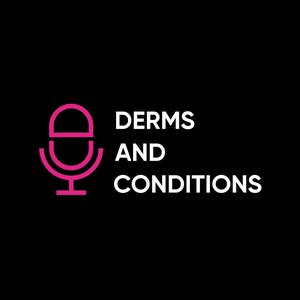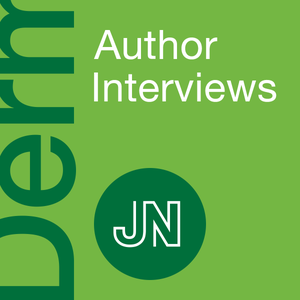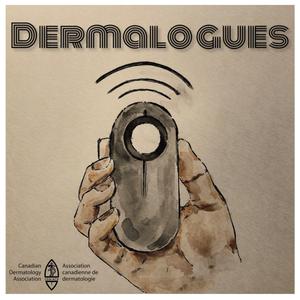
Derms and Conditions
Dermsquared
- 30 minutes 22 secondsImproving Your Clinical Approach To Chronic Urticaria
In this episode of Derms and Conditions, host James Q Del Rosso, DO, engages in a comprehensive discussion with Jason Hawkes, MD, MS, FAAD, a medical dermatologist in Rocklin, CA, on chronic spontaneous urticaria (CSU). They discuss CSU’s position in the spectrum of urticarial conditions, explore differential diagnoses and treatment strategies, and offer a wealth of valuable insights into this complex disease.
They begin by defining urticaria as a collection of conditions, explaining that this is often not well-delineated in textbooks or literature. Dr Hawkes categorizes urticaria into acute and chronic types, with chronic further divided into chronic inducible urticaria, which results from an identifiable trigger, and chronic spontaneous urticaria, which has no clear cause.
They then explore differential diagnoses for CSU, including drug-induced urticarial reactions and conditions like mastocytosis or urticarial bullous pemphigoid that require thorough consideration.
Transitioning to treatment strategies, they evaluate the use of systemic corticosteroids like prednisone for short-term relief in patients with CSU, taking into account reservations about long-term efficacy and potential side effects. Antihistamines are also highlighted for their rapid action, with Dr Hawkes encouraging prompt dosage adjustments if initial doses are ineffective.
The conversation shifts to omalizumab, an injectable anti-IgE monoclonal antibody that has waned in popularity among dermatologists due to practical limitations and concerns over anaphylaxis risk. However, it is highlighted as a very effective treatment option for many patients with CSU, as it is amenable to office administration with low rates of anaphylaxis in real-world practice and has a broad consensus for use in guidelines.
They conclude by touching on newer therapies in development that target alternative mechanisms, such as BTK and SYK inhibitors, which will broaden the therapeutic alternatives for patients with CSU.
Tune into the full episode to gain a deeper understanding of CSU and glean invaluable insights into the nuances of this multifaceted condition.
25 April 2024, 11:00 am - 19 minutes 56 secondsOutside the Box: The Power of Combining Art and Science
In this episode of Derms and Conditions, host James Q Del Rosso, DO, interviews Naiem Issa, MD, PhD, FAAD, a dermatologist and dermatologic surgeon practicing at Forefront Dermatology in Vienna, VA, to discuss innovative approaches to treating challenging conditions. From exploring groundbreaking treatments for vitiligo to the mechanisms behind systemic responses in inflammatory diseases, this episode offers valuable insights into the intersection of art and science in dermatology.
The conversation begins with a focus on a novel combination treatment for a challenging disease state: vitiligo. Dr Issa explores the potential of combining topical ruxolitinib with microneedling to promote repigmentation. He explains the rationale behind this approach, citing the proinflammatory cytokine milieu induced by microneedling, which can promote melanogenesis and repigmentation. He shares a successful case study involving a pediatric patient with segmental vitiligo who, after failing multiple other therapies, achieved significant repigmentation after undergoing this combined treatment.
The discussion then shifts to Dr Issa's experiences with observing responses in untreated areas of inflammatory disease after treating a specific area. They consider the possible mechanisms of action behind this phenomenon and discuss the case of pediatric patient with severe atopic dermatitis who saw improvement in untreated areas after applying tapinarof to symptomatic areas, suggesting a possibly systemic anti-inflammatory effect mediated by regulatory T cells.
Their discussion concludes by addressing the critical unmet need in the supply chain for epinephrine and the impact on clinical practice where lidocaine with ephinephrine is necessary for local anesthetic use. They discuss midodrine, an alpha-1-specific agonist, as an alternative to epinephrine, with findings indicating that midodrine allows for the reduction of epinephrine needed in lidocaine combinations and the significant effects observed at lower dilutions.
Tune in to the full episode to hear more about Dr Issa’s innovative approaches, groundbreaking research, and cutting-edge strategies that address critical needs in dermatology!
11 April 2024, 2:00 pm - 26 minutes 55 secondsComprehensive Management of Hidradenitis Suppurativa: Expert Insights From Dr Jennifer Hsiao
In this episode of Derms and Conditions, host James Q Del Rosso, DO, sits down with Jennifer Hsiao, MD, associate professor of clinical dermatology at Keck Medicine of University of Southern California, to discuss the multifaceted world of hidradenitis suppurativa (HS). From addressing diagnostic obstacles to understanding comorbidities, this episode guides clinicians through the many complexities of HS management.
They begin by exploring the diagnostic hurdles associated with HS, with Dr Hsiao sharing insights to help clinicians navigate through potential misdiagnoses. She emphasizes the importance of recognizing subtle indicators of the disease and thinking outside the box when it comes to the location of lesions, as they may present in atypical areas. She also highlights the significance of recurrent history, which can serve as a diagnostic hallmark.
Next, the pair discusses comorbidities associated with HS, with Dr Hsiao detailing the importance of inquiring about patients' primary care arrangements. She notes that while dermatologists may not directly manage these comorbidities, they can play a vital role in identifying and initiating the necessary steps toward management.
The discussion then moves to the significant psychological impact of HS, emphasizing the necessity of open dialogue with patients about the psychological toll of HS and the benefits of seeking mental health support. Screening tools like the PHQ-2 can aid in identifying patients at risk and initiating necessary interventions.
They next address the limitations of current clinical guidelines for HS and the need for a paradigm shift towards intervening earlier in the disease process to prevent irreversible tissue damage.
The discussion concludes with the presentation of a clinical scenario describing a patient transitioning from oral antibiotics to a biologic, with Dr Hsiao outlining her suggested approach for such a patient.
28 March 2024, 10:00 am - 33 minutes 23 secondsPart 2: Special Edition on Recent Reports of Benzene Found in Benzoyl Peroxide Products
In this 2-part special edition of Derms and Conditions, host James Q Del Rosso, DO, sits down with David Light, cofounder and president of Valisure, and Christopher Bunick, associate professor of dermatology and translational medicine at Yale University and medical and dermatologic advisor for Valisure, to shed light on Valisure’s recent Citizen Petition to the US Food and Drug Administration regarding findings of high levels of benzene in benzoyl peroxide-containing products.
In Part 1, Dr Del Rosso interviews David Light, cofounder and president of Valisure, an independent quality assurance company that aims to address a critical gap in the health care supply chain. Dr Del Rosso and Mr Light delve into the details regarding how a product review gets initiated, the financial source of such reviews, and the important differences between Valisure’s work and that of Good Manufacturing Practice (GMP) testing facilities. Finally, they address the impact that manufacturing issues have on the increasing incidences of drug shortages in the United States.
In Part 2, Dr Del Rosso continues his conversation with David Light to discuss stability testing—what it is, why it’s important, and how Valisure undertook stability testing on products containing benzoyl peroxide. Mr Light details the rationale for conducting accelerated stability testing at elevated temperatures to evaluate the safety of the products across their entire lifecycles. Dr Bunick also joins the conversation to comment on the misperceptions about FDA-allowable limits of benzene in consumer products and the urgent need for change in how products are evaluated and formulated to ensure patient safety first and foremost. Lastly, Dr Del Rosso and Dr Bunick discuss how dermatologists should counsel patients in the short term on minimizing the risk of benzene exposure while we await further testing, external validation, and regulatory guidance.
21 March 2024, 11:05 am - 22 minutes 56 secondsPart 1: Special Edition on Recent Reports of Benzene Found in Benzoyl Peroxide Products
In this 2-part special edition of Derms and Conditions, host James Q Del Rosso, DO, sits down with David Light, cofounder and president of Valisure, and Christopher Bunick, associate professor of dermatology and translational medicine at Yale University and medical and dermatologic advisor for Valisure, to shed light on Valisure’s recent Citizen Petition to the US Food and Drug Administration regarding findings of high levels of benzene in benzoyl peroxide-containing products.
In Part 1, Dr Del Rosso interviews David Light, cofounder and president of Valisure, an independent quality assurance company that aims to address a critical gap in the health care supply chain. Dr Del Rosso and Mr Light delve into the details regarding how a product review gets initiated, the financial source of such reviews, and the important differences between Valisure’s work and that of Good Manufacturing Practice (GMP) testing facilities. Finally, they address the impact that manufacturing issues have on the increasing incidences of drug shortages in the United States.
In Part 2, Dr Del Rosso continues his conversation with David Light to discuss stability testing—what it is, why it’s important, and how Valisure undertook stability testing on products containing benzoyl peroxide. Mr Light details the rationale for conducting accelerated stability testing at elevated temperatures to evaluate the safety of the products across their entire lifecycles. Dr Bunick also joins the conversation to comment on the misperceptions about FDA-allowable limits of benzene in consumer products and the urgent need for change in how products are evaluated and formulated to ensure patient safety first and foremost. Lastly, Dr Del Rosso and Dr Bunick discuss how dermatologists should counsel patients in the short term on minimizing the risk of benzene exposure while we await further testing, external validation, and regulatory guidance.
21 March 2024, 11:00 am - 32 minutes 10 secondsPrescribed Success: Navigating Buy-and-Bill Strategies in Dermatology Practice
In this episode of Derms and Conditions, our host, James Q. Del Rosso, DO, interviews Cory Rubin, MD, dermatologist and owner of the Michigan Dermatology Institute, about the business side of running a practice, with specific focus on the buy-and-bill model.
Dr Rubin shares some of the challenges he has faced and explains the value of buy-and-bill for dermatologists, particularly in complex cases where medications may not be easily accessible through traditional pharmacies. They cover suitable medications, such as biologics for psoriasis, cutaneous T-cell lymphoma, and other conditions, as well as the financial benefits, clinical advantages, and patient convenience associated with in-office administration.
The conversation dives into the practical aspects of implementing buy-and-bill. They explore the importance of understanding insurance processes, obtaining prior authorizations, and tracking patient outcomes. The pair emphasize the need to start small, gradually expanding buy-and-bill capabilities while ensuring proper documentation and reimbursement.
Dr Rubin offers rich practical advice and reiterates the importance of mentorship and seeking assistance from experts in billing and reimbursement. He also extends an invitation for further consultation via email and expresses his willingness to support colleagues in navigating the complexities of practice management. This episode is a valuable listen for dermatologists looking to optimize their practice operations and enhance patient care through buy-and-bill.
14 March 2024, 10:00 am - 20 minutes 25 secondsHighlights of Winter Clinical Miami 2024
In this episode of Derms and Conditions, our host, James Q. Del Rosso, DO, interviews pediatric dermatologist Lisa Swanson, MD, live at Winter Clinical Miami 2024 to review conference highlights and discuss diagnosing and treating molluscum contagiosum, herpes labialis in the adolescent population, and newer and emerging therapies for chronic skin diseases like atopic dermatitis and acne.
Dr Swanson discusses the recent FDA approval of cantharidin and berdazimer gel for molluscum contagiosum and the challenges of diagnosing single lesions. She highlights the importance of providing accurate information to schools and daycares about the contagiousness of the virus and the unnecessary quarantine measures that are often enforced.
The pair share their excitement about the ability to profoundly impact patients' lives with newer therapies for chronic conditions, particularly bimekizumab, an anti-IL17A and anti-IL17F for plaque psoriasis, and oral deucravacitinib, a TYK2 inhibitor for plaque psoriasis that now has 3-year efficacy and safety data.
They also discuss the presentation of herpes labialis in adolescents, with Dr Swanson emphasizing the marked severity of the primary outbreak, the importance of counseling these patients on managing outbreaks, and making efforts to destigmatize this condition among this population.
Dr Swanson also looks forward several anticipated FDA approvals which include lebrikizumab for atopic dermatitis, both topical tapinarof and topical roflumilast also for atopic dermatitis including young children, and the approval of topical ruxolitinib extended to younger children. She also emphasizes that emerging access to acne medications in children of younger ages is important as puberty develops earlier. She discusses the effectiveness of clindamycin, benzoyl peroxide, and adapalene as a once daily combination treatment for acne and the availability of topical clascoterone, an androgen receptor inhibitor, which can be used twice daily for both adolescent girls and boys with acne.
They conclude with a discussion on the importance of character and kindness in the field of dermatology based on a presentation at the meeting by special guest speaker Lori Greiner, which Dr Swanson demonstrates through her expressed willingness to help those without access to a pediatric dermatologist and an open-door policy for clinical consultation.
29 February 2024, 11:00 am - 28 minutes 47 secondsTapping Into Tapinarof: An In-Depth Look at the Novel Treatment for Psoriasis with Dr April Armstrong
In this episode of Derms and Conditions, our host, James Q. Del Rosso, DO, interviews April Armstrong, MD, MPH, a professor and Chief of Dermatology at UCLA, about the development of tapinarof, a novel nonsteroidal topical treatment for psoriasis.
They begin by discussing Dr Armstrong’s history of professional interest in psoriasis. The conversation then moves to focus solely on tapinarof, a topical cream that works by modulating the aryl hydrocarbon receptor (AhR).
Dr Armstrong explains the unique mechanism of action of tapinarof and its effects on Th17 cytokines, antioxidant activity, and skin barrier function. She also discusses the efficacy demonstrated in clinical trials, with nearly 40% of patients achieving PASI 75 after 12 weeks, as well as the remittive effect in maintaining clear or almost clear skin.
They address the safety profile of tapinarof, including the occurrence of folliculitis and contact irritation, and provide tips for its use in clinical practice. Dr Armstrong also emphasizes its versatility and potential as a combination therapy with systemic medications. All in all, the episode provides listeners with an expansive understanding of tapinarof as an effective and well-tolerated nonsteroidal treatment for plaque psoriasis.
22 February 2024, 4:09 pm - 16 minutes 59 secondsHighlights of Winter Clinical Hawaii 2024
In this episode of Derms and Conditions, our host, James Q. Del Rosso, DO, is joined by April Armstrong, MD, MPH, and David Cohen, MD, MPH, live at Winter Clinical Hawaii 2024 to review highlights from the conference.
They cover a diverse slate of topics, including the 2023 allergen of the year (lanolin), notable advancements in psoriasis treatment including topicals and biologics, updates on diagnostic tools for melanoma, and clinical pearls for treating actinic keratosis with combinations of cryosurgery, topical field therapy, and PDT. The group reviews guidelines for atopic dermatitis and effective therapies like omalizumab and oral antihistamines for chronic spontaneous urticaria and secukinumab for hidradenitis suppurativa, as well as the need to improve outdated clinical guidance in the US.
Together, they examine the evolving role of artificial intelligence in dermatology and underscore the importance of practitioner well-being. From new therapies to new indications, tune in to hear a poignant analysis of key themes from the meeting this year.
25 January 2024, 10:00 am - 35 minutes 10 secondsA Deep Dive Into IL-17 Inhibition and Bimekizumab for Psoriasis: Straight Talk with Dr Andy Blauvelt
In this episode of Derms and Conditions, Andy Blauvelt, MD, joins James Q. Del Rosso, DO, to discuss IL-17 inhibition, with a focus on bimekizumab as a treatment for psoriasis. Bimekizumab is unique for inhibiting both IL-17A and IL-17F, demonstrating higher efficacy and a favorable safety profile. Dr Blauvelt highlights the drug's mechanism of action and covers its approval process, global use, and notable data. He emphasizes its efficacy in achieving Psoriasis Area Severity Index 100 (PASI 100) clearance.
The pair discusses bimekizumab’s dosing schedule, with an induction dosing period of once a month for 16 weeks followed by maintenance dosing every 8 weeks, a unique feature compared with other IL-17 blockers. Dr Blauvelt emphasizes bimekizumab's exceptional efficacy, with rapid and sustained results, reaching close to 60% of patients achieving PASI 100 after a single dose and around 70% within a year.
The discussion includes comparisons with other IL-17 blockers, addressing the drug's suitability for different patient profiles. Safety considerations, such as oral candidiasis, are explored, with Dr Blauvelt providing insights into managing these side effects. The conversation delves into additional areas of interest, such as ongoing studies for psoriatic arthritis (PsA) and hidradenitis suppurativa (HS).
Regarding safety, they touch on topics like suicidal ideation and liver enzyme elevations. Dr Blauvelt emphasizes the importance of understanding the baseline risks associated with mental health issues in patients with psoriasis. The FDA's cautious approach is acknowledged, and Dr Blauvelt provides context, comparing bimekizumab with other biologics in terms of suicidal ideation data.
In summary, Dr Blauvelt expresses enthusiasm for bimekizumab as a new and highly effective option for patients with psoriasis, citing its remarkable efficacy and potential future indications for PsA and HS. The episode concludes with a discussion on scalp psoriasis and bimekizumab's positive impact on treating this condition.
4 January 2024, 10:00 am - 30 minutes 52 secondsFinal Thoughts from 2023: Highlights from Podcasts Past…
In this episode of Derms and Conditions, our host, Dr James Q. Del Rosso, reflects on the past year of podcasting, offering a rich summary of key dermatologic topics discussed throughout 2023.
To start, the episode delves into highlights from an interview with Dr Shane Chapman, who specializes in skin cancer. Dr Chapman shares insights into nonsurgical options for treating nonmelanoma skin cancer, focusing on strategies for cases of squamous cell carcinoma and nodular basal cell carcinoma that may not be amenable to surgical treatment for a variety of reasons.
Next, Dr Del Rosso features an episode with Dr Adam Friedman, who explores the topic of sensitive skin as a standalone entity. They highlight the prevalence of sensitive skin and the need for dermatologists to acknowledge and address this poorly understood condition with an open-minded approach.
In another segment, Dr Del Rosso revisits the work of Dr Matt Zirwas, who specializes in chronic dermatitis and inflammatory skin diseases. Dr Zirwas shares valuable insights on diagnosing scabies and addresses concerns about the differentiation of cutaneous T cell lymphoma from atopic dermatitis in older patients.
Dr Del Rosso concludes with a review of a 2-part series featuring Dr Jeff Donovan, who provides comprehensive insights into alopecia areata. Dr Donovan discusses the many mimickers of alopecia areata and when and how to conduct a biopsy. He reviews treatment options for alopecia areata and discusses the efficacy of newer agents, such as JAK inhibitors, to treat severe alopecia areata. The use of dupilumab in selected cases, especially in children with both alopecia areata and atopic dermatitis, is also reviewed. Other relevant suggestions from Dr Donovan include his perspectives on both clinical and laboratory assessments, his discussion of other inflammatory hair diseases, and tips on differentiating these other hair disorders from alopecia areata along with suggestions on management approaches.
Overall, Dr Del Rosso provides a comprehensive review, sharing insights and practical tips from featured experts. It was a great year for the Derms and Conditions podcast, mostly because of those who listened in and the expert faculty who shared their expertise so openly.
In conclusion, Dr Del Rosso encourages engagement and feedback from the audience to help shape the direction of future podcast episodes.
28 December 2023, 11:00 am - More Episodes? Get the App
Your feedback is valuable to us. Should you encounter any bugs, glitches, lack of functionality or other problems, please email us on [email protected] or join Moon.FM Telegram Group where you can talk directly to the dev team who are happy to answer any queries.
 JAMA Dermatology Author Interviews
JAMA Dermatology Author Interviews
 Dermalogues
Dermalogues
 Learn Skin with Dr. Raja and Dr. Hadar
Learn Skin with Dr. Raja and Dr. Hadar
 The Grenz Zone
The Grenz Zone
 Dermasphere - The Dermatology Podcast
Dermasphere - The Dermatology Podcast
 The Dermatology Digest Podcast Exclusives
The Dermatology Digest Podcast Exclusives